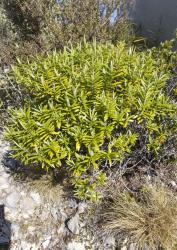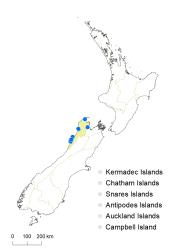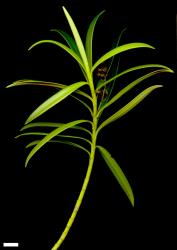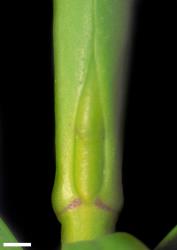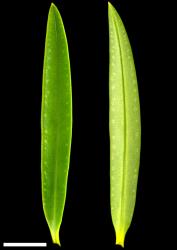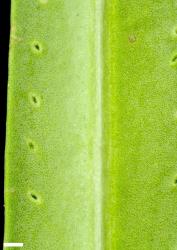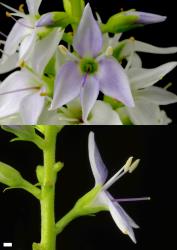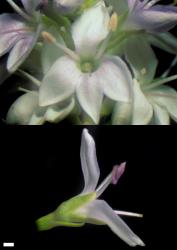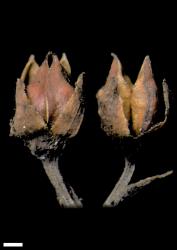- ≡ Hebe townsonii (Cheeseman) Cockayne & Allan, Trans. New Zealand Inst. 57: 20 (1926)
- ≡ Veronica macrocarpa var. crassifolia Cheeseman, Man. New Zealand Fl. 505 (1906)
Shrub to 2.5 m tall. Stems erect, eglandular-puberulent or glabrous; hairs bifarious. Leaf bud distinct, its leaves appressed at margins until fully grown; sinus acute. Leaves opposite-decussate, erecto-patent to spreading, becoming recurved; lamina coriaceous, linear to narrowly lanceolate, 24–80 mm long, 4–9 mm wide, glossy green to dark green above, dull pale green beneath; midrib evident; surfaces glabrous or rarely some eglandular hairs along midrib above; margin glabrous or papillate to ciliolate, entire; apex narrowly acute; base abruptly cuneate; petiole 2–5 mm. Inflorescence a lateral raceme (very rarely tripartite), 50–120 mm long; flowers crowded, 21–42, female or bisexual on separate plants, ⚥ ≈ ♀; bracts alternate, or opposite below and becoming alternate above, lanceolate to narrowly deltoid, slightly < to slightly > pedicels; pedicels erecto-patent, 2–8 mm long, glabrous or puberulent all around with eglandular or glandular or mixed hairs. Calyx lobes 4 or 5 (5th lobe small, posterior), 3.5–4.2 mm long, sub-equal, glandular ciliolate or mixed glandular- and eglandular-ciliolate. Corolla 9–15 mm diameter; tube white, 1.0–2.5 mm long, < calyx, glabrous; lobes 4, white or pale purplish to bluish, erecto-patent to recurved, sub-equal, lanceolate to narrowly elliptic, 5–8 mm long, acute; nectar guides absent. Stamen filaments white, 4.5–6.0 mm long; anthers purplish, sometimes cream. Style glabrous or occasionally a few hairs at base, 4.5–7.0 mm long. Capsules latiseptate, sub-acute to acute, glabrous or occasionally a few hairs at apex, 3.5–5.5 mm long, 3–4 mm at widest point. Seeds broadly ellipsoid-ovoid to discoid, flattened, smooth, brown, 1.0–1.4 mm long.
Veronica townsonii leaves have a distinctive row of pits, usually referred to as domatia, running parallel between each margin and the midrib on the abaxial surface. These are small slits or holes and appear to be filled with short hairs. Their function is unknown and unlike domatia in other plants they are not associated with a vein axil. These domatia are unique in Veronica and a reliable identification marker for V. townsonii.
Narrow, coriaceous, bright green leaves in this size range are also unusual in Veronica. V. stenophylla plants can have leaves this size and shape, but they are usually narrower and darker green, thinner in texture, and lack domatia; also, V. stenophylla plants do not have a sinus and their corolla lobes are small and rounded.
South Island: Western Nelson (from an isolated population on Mt Burnett to Punakaiki, with a single record from Graham Valley, Arthur Range). Records from Mt Messenger in Taranaki have not been verified by recent collections and are believed to have been planted there (see Bayly & Kellow 2006).
Among scrub on rocks and in gorges in calcium-rich rocks. Recorded elevations range from 40 to 640 m.
Flowers: September–November, sometimes to January; fruits: October–February, persisting until August.
2n = 40 (see Bayly & Kellow 2006, as Hebe townsonii).
Veronica townsonii is classified in V. subg. Pseudoveronica sect. Hebe and the informal group “Apertae” (large-leaved) (Albach & Meudt 2010; Bayly & Kellow 2006). ITS sequence data appear to place V. townsonii among species characterised by mostly small, glaucous leaves. However, in their growth form and especially in the shape of the flowers, V. townsonii plants seem instead to be very similar to northern hebes such as V. pubescens.
Plants on Mt Burnett tend to be glabrous or almost glabrous compared to those from the rest of the range. The latter, however, vary, from having very short, mostly glandular hairs on the inflorescence axis and pedicels (e.g., at Nile River) to having very short, mostly eglandular hairs (other sites near Westport).



